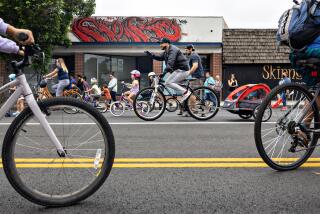Curbing the parking crunch by cutting disabled placard abuse
Cities should set the right prices for curb parking because the wrong prices do so much harm. A yearlong study in 1984 estimated that cruising for underpriced and overcrowded curb parking on 15 blocks of Westwood Village created about 950,000 vehicle-miles of travel a year, equivalent to 38 trips around Earth or four trips to the moon. This cruising wasted 47,000 gallons of gasoline and produced 728 tons of greenhouse gases. Studies have found similar results in other cities.
Because underpriced curb parking causes so much cruising, transportation experts around the world are watching California’s experiments with flexible prices at curb parking meters. In San Francisco, the SFpark program charges meter rates that vary by location and time of day, depending on demand, to create one or two open spaces on each block. Los Angeles recently adopted a similar pilot program called LA Express Park that operates in parts of downtown. If these programs work as planned, drivers will usually see an open curb space on every metered block.
Parking fees that rise and fall with demand can reduce cruising, but new flexible programs in San Francisco and Los Angeles suffer from a problem that is rampant throughout the state: disabled placard abuse. California allows drivers with disabled placards to park free for an unlimited time at any on-street meter. If cities increase the price of curb parking on crowded blocks to create a few open spaces, they also increase the financial incentive to misuse disabled placards. Higher meter rates may simply drive out paying parkers and make more spaces available for placard abusers.
In 2010, a UCLA survey of placard use on several blocks in downtown Los Angeles found that cars with disabled placards occupied most of the curb spaces most of the time. For five hours of the day, cars with placards occupied every space on one block. The meter rate was $4 an hour, but the meters earned only 32 cents an hour because cars with placards consumed 80% of the meter time. Drivers with disabled placards were often seen carrying heavy loads between their cars and the adjacent businesses.
The problem is not confined to California. Studies in other states have found flagrant placard abuse. When police officers in Alexandria, Va., interviewed drivers who returned to cars displaying disabled placards, they found that 90% were using them illegally. These placard abusers are, in essence, stealing money from the city and depriving genuinely disabled drivers of a convenient place to park.
Reforms in other states show how to end placard abuse at meters. Michigan, for example, adopted a two-tier system that takes into account different levels of disability. Drivers with severe disabilities receive special placards that allow them to park free at meters. Drivers with less severe disabilities receive ordinary placards and must pay at meters. Before this reform, Michigan had issued 500,000 disabled placards that allowed all users to park free at meters. After the state enacted its two-tier reform, only 10,000 drivers applied for the special placards that allow free parking at meters. Enforcement is simplified because any able-bodied driver who uses a severe disability placard is conspicuously breaking the law.
Illinois adopted a similar two-tier placard reform after Chicago Mayor Rahm Emanuel learned that free parking at meters for disabled placard users cost the city $22 million last year, about 25% of the total meter revenue. Raleigh, N.C., allows placard users to park for an unlimited time at meters but requires them to pay for all the time they use. Some cities also make it easier for placard holders to use their cellphones to pay for parking by waiving the usual surcharge of about 30 cents for each transaction.
How would these reforms affect the flexible prices for parking in San Francisco and Los Angeles? During the first year of SFpark, prices declined at 31% of the 7,000 meters, remained the same at 37% and increased at 32%. If the reform reduces placard abuse at meters, more spaces will open up for paying customers. Prices would then go down to fill the more plentiful open parking spots. But with more spaces available, more parkers would pay for the time they use. Total revenue could increase or decrease, but one thing is clear: The lower prices and greater availability of spaces would benefit almost everyone except placard abusers.
Disabled placard abuse is both despicable and ubiquitous. Now it also undermines innovative programs like SFpark and LA Express Park that promise to reduce traffic congestion and greenhouse gas emissions. Other states have shown the way. California now needs only political will to end disabled placard abuse.
Donald Shoup is professor of urban planning at UCLA’s Luskin School of Public Affairs.
More to Read
A cure for the common opinion
Get thought-provoking perspectives with our weekly newsletter.
You may occasionally receive promotional content from the Los Angeles Times.






